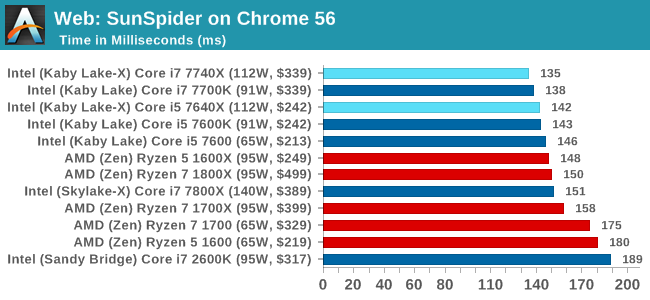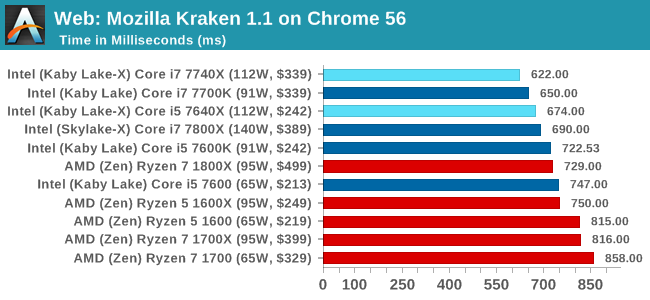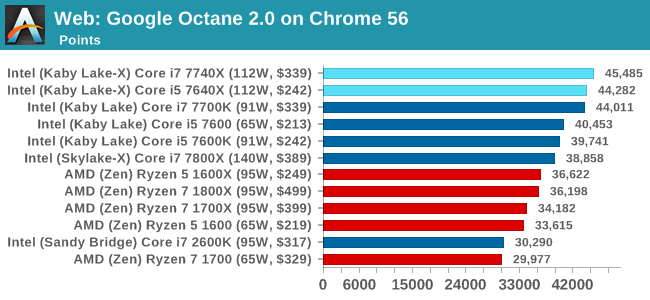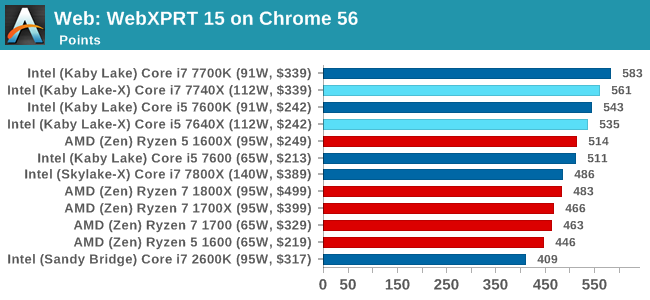The Intel Kaby Lake-X i7 7740X and i5 7640X Review: The New Single-Threaded Champion, OC to 5GHz
by Ian Cutress on July 24, 2017 8:30 AM EST- Posted in
- CPUs
- Intel
- Kaby Lake
- X299
- Basin Falls
- Kaby Lake-X
- i7-7740X
- i5-7640X
Benchmarking Performance: CPU Web Tests
One of the issues when running web-based tests is the nature of modern browsers to automatically install updates. This means any sustained period of benchmarking will invariably fall foul of the 'it's updated beyond the state of comparison' rule, especially when browsers will update if you give them half a second to think about it. Despite this, we were able to find a series of commands to create an un-updatable version of Chrome 56 for our 2017 test suite. While this means we might not be on the bleeding edge of the latest browser, it makes the scores between CPUs comparable.
All of our benchmark results can also be found in our benchmark engine, Bench.
SunSpider 1.0.2: link
The oldest web-based benchmark in this portion of our test is SunSpider. This is a very basic javascript algorithm tool, and ends up being more a measure of IPC and latency than anything else, with most high-performance CPUs scoring around about the same. The basic test is looped 10 times and the average taken. We run the basic test 4 times.

SunSpider has a single threaded focus, and we see the Kaby Lake-X processors take their spots at the top of the graph.
Mozilla Kraken 1.1: link
Kraken is another Javascript based benchmark, using the same test harness as SunSpider, but focusing on more stringent real-world use cases and libraries, such as audio processing and image filters. Again, the basic test is looped ten times, and we run the basic test four times.

Mozilla too relies on single threaded IPC and frequency.
Google Octane 2.0: link
Along with Mozilla, as Google is a major browser developer, having peak JS performance is typically a critical asset when comparing against the other OS developers. In the same way that SunSpider is a very early JS benchmark, and Kraken is a bit newer, Octane aims to be more relevant to real workloads, especially in power constrained devices such as smartphones and tablets.

Octane is an interesting benchmark, requiring cores and ST performance, but mostly the latter. It also seems that either Intel's design is optimized for the benchmark or vice versa, given the substantial difference in performance. There's no way for the benchmark to use all of the threads from AMD, nor the 12 threads in the Core i7-7800X which has a lower single thread performance.
WebXPRT 2015: link
While the previous three benchmarks do calculations in the background and represent a score, WebXPRT is designed to be a better interpretation of visual workloads that a professional user might have, such as browser based applications, graphing, image editing, sort/analysis, scientific analysis and financial tools.

WebXPRT is a mix of ST and MT, but still based in the web and relies on ST performance a lot. Given the variable loading on the benchmark, Intel's newest features such as Speed Shift help keep it at the top.










176 Comments
View All Comments
Firebat5 - Tuesday, July 25, 2017 - link
Ian,i'm interested in the details of the agility benchmark? how many photos are in your dataset and at what resolution? am doing similar work and i notice the working time doesn't seem to be linear with the number of photos.
Firebat5 - Tuesday, July 25, 2017 - link
agisoft* autocorrect strikes again.damianrobertjones - Thursday, July 27, 2017 - link
Capitals can be a good thing.Gothmoth - Tuesday, July 25, 2017 - link
reading this article again i must say im realyl ashamed. anandtech was once a great place but now it´s just like car magazines. who pays best gets the best reviews. where is the criticism? everyone and his grandmother things intel has big issues (tim, heat, pci lanes nonsense product) are you bend over so intel can inject more money more easily?damianrobertjones - Thursday, July 27, 2017 - link
Is your shift key broke? Where's are your capitals?zodiacfml - Wednesday, July 26, 2017 - link
Impressive benchmarks. I could not ask for more. This revealed that Intel clearly doesn't have the premium or value position anymore. It is simply not there. They have to be in the 10nm process now to be superior in value and/or performance.Walkeer - Wednesday, July 26, 2017 - link
Hi, what RAM frequency is the AMD platform running on? if its the official maximum of 2666MHz, you can get +10-15% more performance using 3200MHz or faster memorywarner001 - Wednesday, July 26, 2017 - link
Hey, This is a very useful post for the new ones. Thanks a lot. please visit http://forums.cat.com/t5/user/viewprofilepage/user...warner001 - Wednesday, July 26, 2017 - link
nice blogedsib1 - Wednesday, July 26, 2017 - link
Please redo the Ryzen benchmarks using DDR3200 now it is officially supported, and also use the latest updates of the games - eg ROTR v770.1+ where Ryzen gets a 25% increase.You can't compare one platform with the latest updates, and the other without - thats pointless